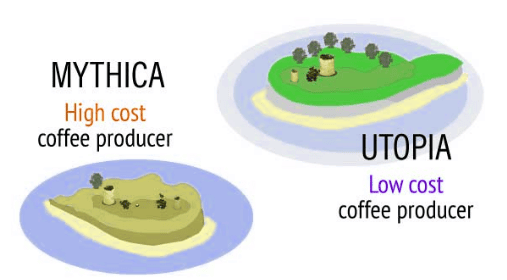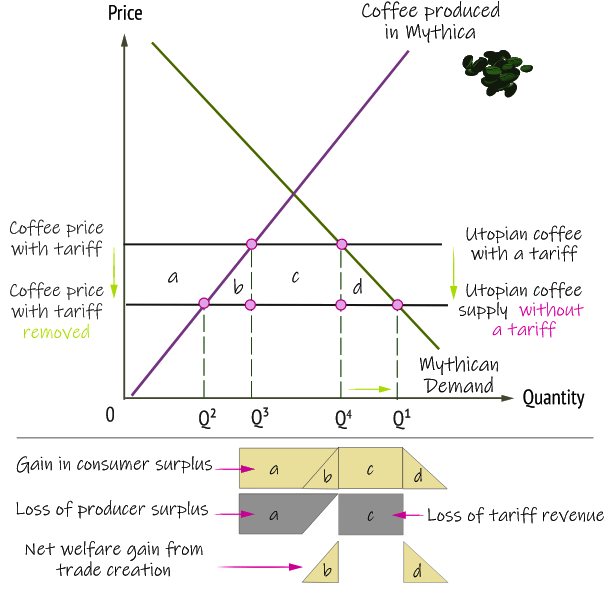Trade Creation and Trade Diversion | Crash Course for UGC NET Commerce PDF Download
| Table of contents |

|
| Trade Creation |

|
| Trading Blocs and Trade Diversion |

|
| Trade Diversion |

|
| Evidence of Trade Creation vs. Trade Diversion |

|
Trade Creation
- Trade creation occurs when countries form a free trade area or customs union and eliminate trade barriers between them.
- Let's consider two countries, Mythica and Utopia, which do not have a free trade agreement for coffee.
- Mythica imposes tariffs to protect its inefficient, high-cost coffee producers, leading to high prices for consumers in Mythica.

- Utopia produces coffee more efficiently, at a lower cost, and with better quality.
- Mythica's tariff raises the price of Utopian coffee, forcing Mythican consumers to buy the cheaper, domestically produced coffee.
- Now, suppose Mythica and Utopia form a free trade area or customs union.
- Mythica is required to remove its tariff on Utopian coffee, making Utopian coffee cheaper in Mythica.
- As a result, consumers in Mythica switch to the more affordable and higher-quality Utopian coffee.
- This process, where consumers benefit from lower-cost imports due to the removal of trade barriers, is known as trade creation.
- The concept of trade creation can be measured by the increase in consumer surplus resulting from the elimination of tariffs.

- In essence, trade creation leads to a net welfare gain due to the newly established trade flows.
Trading Blocs and Trade Diversion
- There are ten major trading blocs globally, ranging from preferential trade areas (PTAs), where members reduce or eliminate tariffs between themselves, to more comprehensive customs unions, such as the European Union, which have agreed-upon common external tariffs.
- As a member of a trading bloc, there is an incentive to trade more with other members, as trade barriers are likely to be fully eliminated. Trade within the bloc often aligns with national specialization and the exploitation of comparative advantage, leading to trade creation.
- Over time, established firms strengthen their trading relationships with partners, and new firms emerge, capitalizing on new trading opportunities. This results in increased trade flows between members. Additionally, dynamic effects such as cost reductions from economies of scale, heightened competition, and greater efficiency may emerge. Productivity tends to increase, leading to GDP growth among bloc members. Gravity Theory supports the idea that regional trading blocs create and expand trade when they grow.
Trade Diversion
However, as trading bloc membership increases, particularly in customs unions, trade with non-members—often located in distant regions—tends to decrease. One downside of trading blocs is that members may miss opportunities to trade with more efficient non-members.
For example, while an inefficient member of a customs union may benefit from trade with more efficient members, trade may be diverted away from even more efficient non-members due to the common external tariff imposed by the customs union.
If we add a third coffee-producing country to our two-country model—one that produces coffee at an even lower cost—the two customs union members might be worse off because of the barriers imposed on this super-efficient non-member. In this case, the customs union leads to trade diversion and reduces the welfare of its members.
Evidence of Trade Creation vs. Trade Diversion
- Europe: After the UK joined the European Common Market in 1972, its trade with member countries increased by 180% between 1972 and 1978. Meanwhile, its trade with former commonwealth nations (Australia, Canada, New Zealand, and South Africa) dropped by 44%.
- While it is evident that trade patterns shifted due to trade creation in industrial goods following the UK's entry into the Common Market, it's less clear how much of the 44% reduction in trade with commonwealth countries was due to trade diversion, leading to efficiency losses. Economists have attempted to quantify the trade effects of trading bloc membership, especially in the EU. The consensus is that all outcomes are possible, ranging from strong trade diversion to strong trade creation effects. These effects also vary across industries, sectors, and individual country characteristics, such as whether a country is landlocked.
- US-China: Although not part of a trading bloc, trade relations between China and the US provide another example of trade diversion. The recent trade war between these two countries has been studied to determine how other countries have benefited from increased tariffs on Chinese imports.
- A 2019 study by UNCTAD found that Taiwan, Mexico, the EU, Vietnam, and Canada all increased their trade with the US as a result of trade restrictions on China. The sectors that benefited the most were office equipment, communications technology, electrical machinery, and chemicals.
|
157 videos|236 docs|166 tests
|
FAQs on Trade Creation and Trade Diversion - Crash Course for UGC NET Commerce
| 1. What is the concept of Trade Creation? |  |
| 2. Can you explain the concept of Trade Diversion? |  |
| 3. How can trading blocs lead to both Trade Creation and Trade Diversion? |  |
| 4. What are some examples of trading blocs that have experienced both Trade Creation and Trade Diversion? |  |
| 5. How can countries determine whether trade within a trading bloc is leading to Trade Creation or Trade Diversion? |  |




















